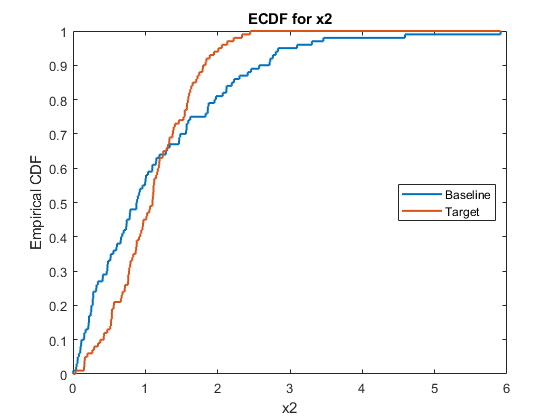ecdf
Compute empirical cumulative distribution function (ecdf) for baseline and target data specified for data drift detection
Since R2022a
Description
E = ecdf(DDiagnostics)E, which stores the ecdf values for all the variables
specified for drift detection in the call to the detectdrift
function.
ecdf returns NaN values for categorical
variables.
E = ecdf(DDiagnostics,Variables=variables)E for the variables specified by
variables.
Examples
Generate baseline and target data with two variables, where the distribution parameters of the second variable change for the target data.
rng('default') % For reproducibility baseline = [normrnd(0,1,100,1),wblrnd(1.1,1,100,1)]; target = [normrnd(0,1,100,1),wblrnd(1.2,2,100,1)];
Perform permutation testing for any drift between the baseline and target data.
DDiagnostics = detectdrift(baseline,target)
DDiagnostics =
DriftDiagnostics
VariableNames: ["x1" "x2"]
CategoricalVariables: []
DriftStatus: ["Stable" "Drift"]
PValues: [0.2850 0.0030]
ConfidenceIntervals: [2×2 double]
MultipleTestDriftStatus: "Drift"
DriftThreshold: 0.0500
WarningThreshold: 0.1000
Properties, Methods
Compute the ecdf values for all variables.
E = ecdf(DDiagnostics)
E=2×3 table
x F_Baseline F_Target
______________ ______________ ______________
x1 {201×1 double} {201×1 double} {201×1 double}
x2 {201×1 double} {201×1 double} {201×1 double}
E is a table with two rows and three columns. The two rows correspond to the two variables, x1 and x2. For each variable, ecdf computes the ecdf values over a common domain for the baseline and target data. The function stores the common domain for each variable in the column x, the ecdf values for the baseline data in the column F_Baseline, and the ecdf values for the target data in the column F_Target.
Access the ecdf values for variable 2 in the baseline data.
E.F_Baseline{2}ans = 201×1
0
0.0100
0.0100
0.0200
0.0300
0.0400
0.0500
0.0600
0.0700
0.0800
⋮
Plot the ecdf values of the baseline and target data for variable x2.
stairs(E.x{2},E.F_Baseline{2},LineWidth=1.5)
hold on
stairs(E.x{2},E.F_Target{2},LineWidth=1.5)
title('ECDF for x2')
xlabel('x2')
ylabel('Empirical CDF')
legend('Baseline','Target',Location='east')
hold off
The plot of the ecdf values also shows the drift in the distribution of the target data.
Load the sample data.
load humanactivityFor details on the data set, enter Description at the command line.
Assign the first 1000 observations as baseline data and the next 1000 as target data.
baseline = feat(1:1000,:); target = feat(1001:2000,:);
Test for drift on all variables.
DDiagnostics = detectdrift(baseline,target);
Compute the ecdf values for only the first five variables.
E = ecdf(DDiagnostics,Variables=[1:5])
E=5×3 table
x F_Baseline F_Target
_______________ _______________ _______________
x1 {2001×1 double} {2001×1 double} {2001×1 double}
x2 {2001×1 double} {2001×1 double} {2001×1 double}
x3 {2001×1 double} {2001×1 double} {2001×1 double}
x4 {2001×1 double} {2001×1 double} {2001×1 double}
x5 {2001×1 double} {2001×1 double} {2001×1 double}
Access the ecdf values for the third variable in the baseline data.
E.F_Baseline{3}ans = 2001×1
0
0
0
0
0
0
0.0010
0.0020
0.0030
0.0040
⋮
Plot the ecdf values of the baseline and target data for variable x3.
stairs(E.x{3},E.F_Baseline{3},LineWidth=1.5)
hold on
stairs(E.x{3},E.F_Target{3},LineWidth=1.5)
title('ECDF for x3')
xlabel('x3')
ylabel('Empirical CDF')
legend('Baseline','Target',Location = 'southeast')
hold off
The ecdf plot shows the drift in the target data for variable x3.
Input Arguments
Diagnostics of the permutation testing for drift detection, specified as a DriftDiagnostics object returned by detectdrift.
List of variables for which to compute the ecdf values, specified as a string array, cell array of character vectors, or list of integer indices.
Example: Variables=["x1","x3"]
Example: Variables=(1,3)
Data Types: single | double | char | string
Output Arguments
ecdf values for all variables specified for drift detection in the call to
detectdrift, returned as a table with the following columns.
| Column Name | Description |
|---|---|
x | Common domain over which to evaluate the empirical cdf |
F_Baseline | ecdf values for the baseline data |
F_Target | ecdf values for the target data |
For each variable in E, the columns store x
and the ecdf values in cell arrays. To access the values, you can index into the table;
for example, to obtain the ecdf values for the second variable in the baseline data, use
E.F_Baseline{2,1}.
Version History
Introduced in R2022a
See Also
detectdrift | DriftDiagnostics | plotDriftStatus | plotEmpiricalCDF | plotHistogram | plotPermutationResults | summary | histcounts
MATLAB Command
You clicked a link that corresponds to this MATLAB command:
Run the command by entering it in the MATLAB Command Window. Web browsers do not support MATLAB commands.
Website auswählen
Wählen Sie eine Website aus, um übersetzte Inhalte (sofern verfügbar) sowie lokale Veranstaltungen und Angebote anzuzeigen. Auf der Grundlage Ihres Standorts empfehlen wir Ihnen die folgende Auswahl: .
Sie können auch eine Website aus der folgenden Liste auswählen:
So erhalten Sie die bestmögliche Leistung auf der Website
Wählen Sie für die bestmögliche Website-Leistung die Website für China (auf Chinesisch oder Englisch). Andere landesspezifische Websites von MathWorks sind für Besuche von Ihrem Standort aus nicht optimiert.
Amerika
- América Latina (Español)
- Canada (English)
- United States (English)
Europa
- Belgium (English)
- Denmark (English)
- Deutschland (Deutsch)
- España (Español)
- Finland (English)
- France (Français)
- Ireland (English)
- Italia (Italiano)
- Luxembourg (English)
- Netherlands (English)
- Norway (English)
- Österreich (Deutsch)
- Portugal (English)
- Sweden (English)
- Switzerland
- United Kingdom (English)